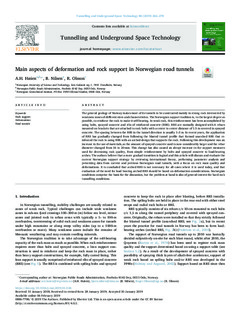| dc.contributor.author | Høien, Are Håvard | |
| dc.contributor.author | Nilsen, Bjørn | |
| dc.contributor.author | Olsson, Roger | |
| dc.date.accessioned | 2019-03-29T12:40:46Z | |
| dc.date.available | 2019-03-29T12:40:46Z | |
| dc.date.created | 2019-02-15T10:25:10Z | |
| dc.date.issued | 2019 | |
| dc.identifier.citation | Tunnelling and Underground Space Technology. 2019, 86 262-278. | nb_NO |
| dc.identifier.issn | 0886-7798 | |
| dc.identifier.uri | http://hdl.handle.net/11250/2592511 | |
| dc.description.abstract | The general geology of Norway makes most of its tunnels to be constructed mainly in strong rock intersected by weakness zones of different sizes and characteristics. The Norwegian support tradition is, to the largest degree as possible, to reinforce the rock to make it self-bearing. In weak rock, this reinforcement has been accomplished by using bolts, sprayed concrete and ribs of reinforced concrete (RRS). RRS are normally designed with 6 rebars mounted on brackets that are attached to rock bolts with a center to center distance of 1.5 m covered in sprayed concrete. The spacing between the RRS in the tunnel direction is usually 1 to 3 m. In recent years, the application of RRS has gradually changed from following the blasted tunnel profile that formed unarched RRS that reinforced the rock to using RRS with an arched design that supports the rock. Following this development was an increase in the use of materials, as the amount of sprayed concrete used is now considerably larger and the rebar diameter changed from 16 to 20 mm. This change has also caused an abrupt increase in the support measures used for decreasing rock quality, from simple reinforcement by bolts and sprayed concrete to load-bearing arches. The authors believe that a more gradual transition is logical and this article will discuss and evaluate the current Norwegian support strategy by reviewing international theory, performing parameter analysis and presenting data from current and previous Norwegian road tunnels, with a focus on rock mass quality and deformations. It is concluded that arched RRS is not necessary for all cases where it is used today, and that evaluation of the need for load bearing arched RRS should be based on deformation considerations. Norwegian conditions comprise the basis for the discussion, but the problem at hand is also of general interest for hard rock tunnelling conditions. | nb_NO |
| dc.language.iso | eng | nb_NO |
| dc.publisher | Elsevier | nb_NO |
| dc.relation.uri | https://authors.elsevier.com/sd/article/S0886779818301330 | |
| dc.rights | Navngivelse 4.0 Internasjonal | * |
| dc.rights.uri | http://creativecommons.org/licenses/by/4.0/deed.no | * |
| dc.title | Main aspects of deformation and rock support in Norwegian road tunnels | nb_NO |
| dc.type | Journal article | nb_NO |
| dc.type | Peer reviewed | nb_NO |
| dc.description.version | publishedVersion | nb_NO |
| dc.source.pagenumber | 262-278 | nb_NO |
| dc.source.volume | 86 | nb_NO |
| dc.source.journal | Tunnelling and Underground Space Technology | nb_NO |
| dc.identifier.doi | 10.1016/j.tust.2019.01.026 | |
| dc.identifier.cristin | 1677562 | |
| dc.description.localcode | 2019 The Authors. Published by Elsevier Ltd. This is an open access article under the CC BY license (http://creativecommons.org/licenses/BY/4.0/). | nb_NO |
| cristin.unitcode | 194,64,90,0 | |
| cristin.unitname | Institutt for geovitenskap og petroleum | |
| cristin.ispublished | true | |
| cristin.fulltext | original | |
| cristin.qualitycode | 1 | |

